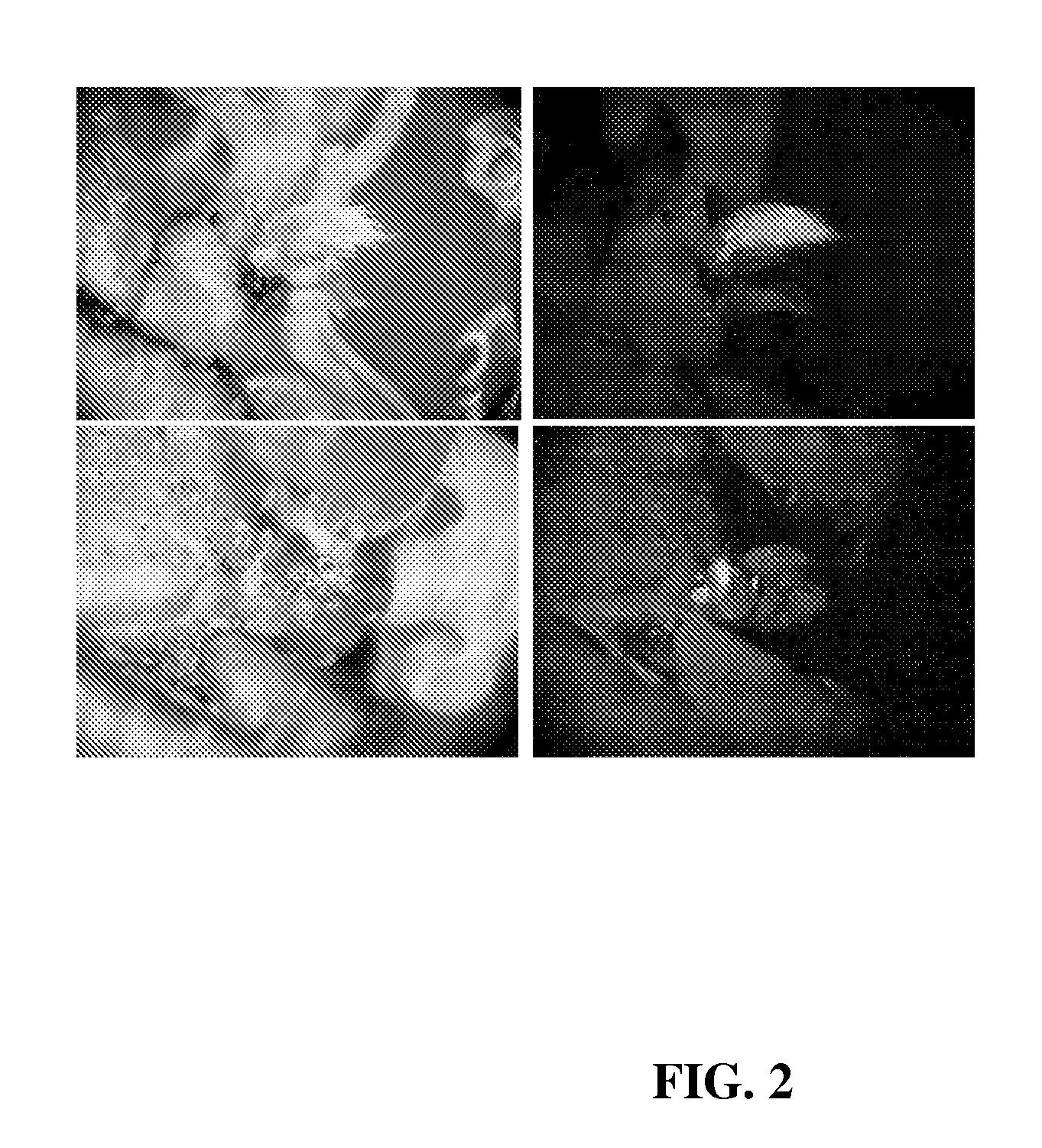Method for selection of transformed cells
a technology of plant cells and cells, applied in the field of plant biotechnology, can solve the problems of not being able to breed selectable markers, requiring labor intensive steps, and becoming particularly difficul
- Summary
- Abstract
- Description
- Claims
- Application Information
AI Technical Summary
Benefits of technology
Problems solved by technology
Method used
Image
Examples
example 1
Preparation of DMO-Encoding Polynucleotide Constructs
[0086]Several binary vectors were prepared for testing the ability of DMO-encoding polynucleotide molecules to allow selection of transformed soybean cells. Genetic elements used for preparing the binary vectors are given in Table 1 and include a CaMV 35S promoter and enhancer (U.S. Pat. Nos. 5,322,938; 5,352,605; 5,359,142; and 5,530,196); GmHsp untranslated leader from the Hsp17.9 gene of Glycine max (U.S. Pat. No. 5,659,122); AvGFPI coding region for the first 126.3 amino acids of the GFP protein from Aequorea victoria (U.S. Pat. Nos. 5,491,084; 6,146,826) with a serine to threonine change at amino acid 65 and optimized for plant expression; a StLS1 second intron from the LS1 gene of Solanum tuberosum (Eckes et al., 1986); an AvGFPII coding region for the last 112.6 amino acids of the GFP protein from Aequorea victoria (U.S. Pat. Nos. 5,491,084; 6,146,826) optimized for plant expression; a T-Atnos 3′ untranslated region of the ...
example 2
Development of Selection Method
[0088]Mature seeds of soybean [Glycine max (L.) Merrill] cv. A3525 were imbibed, sterilized, and germinated at room temperature as set forth below. Other examples of soybean genotypes that can readily be used include, but are not limited to, Jack, Williams, Bert, Thorne, Granite, Lambert, Chapman, and Kunitz. Briefly, dry seeds (about 770 g) were soaked for 3 min in 2 L of 200 ppm sodium hypochlorite solution made from commercially available Clorox. The solution was drained and the seeds were set side for about 2 h. About 2 L of bean sterilization / germination medium was then added to the seeds. After about 9-10 h, seeds were ready for hand excision of explants. The bean germination medium contained the following in mg / L—NH4NO3: 240, KNO3: 505, CaCl2.2H2O: 176, MgSO4.7H2O: 493, KH2PO4: 27, H3BO3: 1.86, Na2MoO4.2H2O: 0.216, MnSO4.H2O: 5.07, ZnSO4. 7H2O: 2.58, FeSO4.7H2O: 2.502, KI: 0.249, Na2EDTA.2H2O: 3.348, CuSO4.5H2O: 0.0008, CoCl2.6H2O: 0.0008, B1: 1...
example 3
Molecular Analysis of Transformed Soybean Plants
[0099]In order to confirm that the dicamba tolerant plants obtained were the result of transfer of DMO-encoding polynucleotides, leaf tissue was collected from each R0 or R1 plant, DNA was extracted, and the presence of the DMO-encoding polynucleotide was confirmed by Invader™ technology (Third Wave Technologies, Madison, Wis.) and Southern blot analysis using non-radioactive probe kit from Roche (Indianapolis, Ind.).
[0100]For the Invader assay, the primers used were: primary probe 5′-acggacgcggag ATGCTCAACTTCATCGC-3′ (SEQ ID NO: 13) and Invader oligo 5′-TCCGCTGGAACA AGGTGAGCGCGT-3′ (SEQ ID NO: 14). The sequence in lower case letters in the primary probe is the 5′ flap sequence which is cleaved and is not complimentary to the target sequence.
[0101]For Southern blot analysis a DNA fragment of 897 bp was used to prepare the probe. The forward primer 5′-GTCGCTGCCCTGCTTGATATT-3′ (SEQ ID NO: 15) and the reverse primer 5′-CGCCGCTTCTAGTTGTTC-...
PUM
| Property | Measurement | Unit |
|---|---|---|
| concentration | aaaaa | aaaaa |
| concentration | aaaaa | aaaaa |
| concentration | aaaaa | aaaaa |
Abstract
Description
Claims
Application Information
 Login to View More
Login to View More - R&D
- Intellectual Property
- Life Sciences
- Materials
- Tech Scout
- Unparalleled Data Quality
- Higher Quality Content
- 60% Fewer Hallucinations
Browse by: Latest US Patents, China's latest patents, Technical Efficacy Thesaurus, Application Domain, Technology Topic, Popular Technical Reports.
© 2025 PatSnap. All rights reserved.Legal|Privacy policy|Modern Slavery Act Transparency Statement|Sitemap|About US| Contact US: help@patsnap.com



